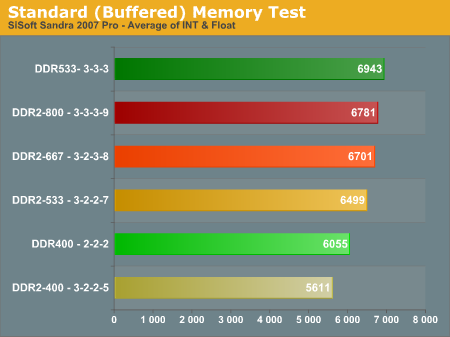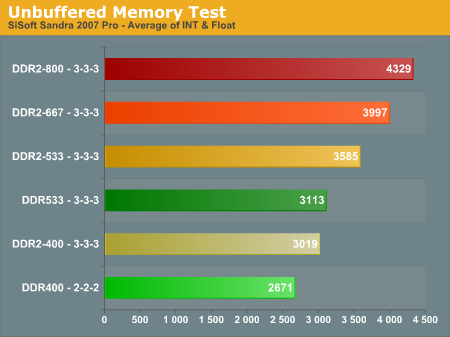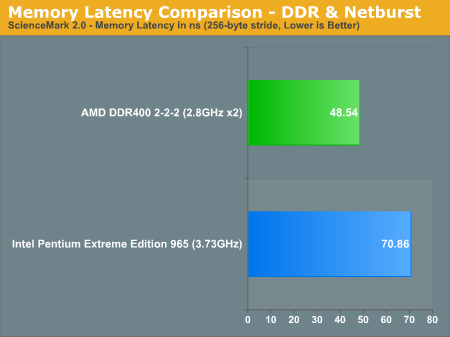DDR/NetBurst Memory Bandwidth and Latency
One of the most talked-about AMD advantages of the last couple of years has been their on-processor memory controller. This has allowed, according to popular theories, the Athlon64 to significantly outperform Intel NetBurst processors. The fact is NetBurst DDR2 bandwidth has recently been similar or wider in bandwidth than Athlon64 - even when the DDR is overclocked. You can see this clearly when we compare Buffered and Unbuffered Bandwidth of a NetBurst 3.46EE to an AMD 4800+ x2(2.4GHz, 2x1MB Cache) running DDR400 2-2-2 and running overclocked memory at DDR533 3-3-3.
The green bars represent DDR memory performance, while the beige to red are increasing DDR2 speed on NetBurst. Light green represents DDR400 2-2-2 while Dark Green is overclocked memory at the same CPU speed, DDR533 at 3-3-3.

In buffered performance, Fast DDR400 is only faster than DDR2-400 and slower than DDR2-533, 667 and 800. Overclocked memory at DDR533 3-3-3 is faster than any of the DDR2 bandwidths on NetBurst.
The Sandra Unbuffered Memory Test, which turns off features that tend to artificially boost performance, is generally a better measure of how memory will behave comparatively in gaming. The same green for DDR applies here.

Without Buffering, DDR400 has the smallest bandwidth of tested memory speeds and timings. Even overclocking to DDR533 allows the DDR to barely beat DDR2-400. DDR2-533, 667, and 800 all have greater Unbuffered bandwidth than the DDR overclocked to 533. NetBurst DDR2 memory bandwidth is generally wider than the bandwidth supplied by DDR memory on Athlon64. Despite the wider bandwidth, the deep pipelines and other inefficiencies in the NetBurst design did not allow the NetBurst processors to outperform Athlon64. Keep this in mind later, when we look at AM2 and Core 2 Duo Memory Bandwidth.
Latency
The other area where AMD has had an advantage over NetBurst DDR2 performance is memory latency, the result of the on-processor memory controller. Comparison of the AMD DDR Memory controller and the Intel DDR2 Memory controller in the Intel chipset shows AMD DDR with latency about 35% lower than Intel NetBurst in Science Mark 2.0.

While memory bandwidth was very similar between AMD and NetBurst, the deep pipes of the NetBurst design still behaved as if they were bandwidth starved. On the other hand the AMD architecture made use of the bandwidth available and the much lower latency to outperform NetBurst across the board.
One of the most talked-about AMD advantages of the last couple of years has been their on-processor memory controller. This has allowed, according to popular theories, the Athlon64 to significantly outperform Intel NetBurst processors. The fact is NetBurst DDR2 bandwidth has recently been similar or wider in bandwidth than Athlon64 - even when the DDR is overclocked. You can see this clearly when we compare Buffered and Unbuffered Bandwidth of a NetBurst 3.46EE to an AMD 4800+ x2(2.4GHz, 2x1MB Cache) running DDR400 2-2-2 and running overclocked memory at DDR533 3-3-3.
The green bars represent DDR memory performance, while the beige to red are increasing DDR2 speed on NetBurst. Light green represents DDR400 2-2-2 while Dark Green is overclocked memory at the same CPU speed, DDR533 at 3-3-3.

In buffered performance, Fast DDR400 is only faster than DDR2-400 and slower than DDR2-533, 667 and 800. Overclocked memory at DDR533 3-3-3 is faster than any of the DDR2 bandwidths on NetBurst.
The Sandra Unbuffered Memory Test, which turns off features that tend to artificially boost performance, is generally a better measure of how memory will behave comparatively in gaming. The same green for DDR applies here.

Without Buffering, DDR400 has the smallest bandwidth of tested memory speeds and timings. Even overclocking to DDR533 allows the DDR to barely beat DDR2-400. DDR2-533, 667, and 800 all have greater Unbuffered bandwidth than the DDR overclocked to 533. NetBurst DDR2 memory bandwidth is generally wider than the bandwidth supplied by DDR memory on Athlon64. Despite the wider bandwidth, the deep pipelines and other inefficiencies in the NetBurst design did not allow the NetBurst processors to outperform Athlon64. Keep this in mind later, when we look at AM2 and Core 2 Duo Memory Bandwidth.
Latency
The other area where AMD has had an advantage over NetBurst DDR2 performance is memory latency, the result of the on-processor memory controller. Comparison of the AMD DDR Memory controller and the Intel DDR2 Memory controller in the Intel chipset shows AMD DDR with latency about 35% lower than Intel NetBurst in Science Mark 2.0.

While memory bandwidth was very similar between AMD and NetBurst, the deep pipes of the NetBurst design still behaved as if they were bandwidth starved. On the other hand the AMD architecture made use of the bandwidth available and the much lower latency to outperform NetBurst across the board.










118 Comments
View All Comments
HSuke - Thursday, July 27, 2006 - link
I hope this means that you're going to do the tests on the Core 2 Duo test platform IN ADDITION to your current platforms.
I hope this does NOT mean that you're going to do the tests EXCLUSIVELY on the Core 2 Duo test platform.
So are you going to stop doing memory tests with AMD processors? How scientific is that? If you go to page 7 and look at the performance charts, you'll see that memory speeds have a much greater impact (pertage-wise) on the AMD setup than the Core 2 Duo setup.
Well, I'm quite surprised that memory even made a difference. But since that is true (according to your tests), shouldn't be testing on AM2 instead of Core 2 Duo processors in the future because the difference is more marked? If there wasn't any significant difference on an Intel system, but a significant difference on an AMD system, you'd probably suggest that memory doesn't make a difference, commiting a type 2 error.
Now, I don't care about memory. I always buy whatever is on sale. But making that conclusion would just piss off so many memory enthusiasts and memory sellers. And aren't those guys the ones that would be reading this article?
Think about it.
Wesley Fink - Friday, July 28, 2006 - link
As we explained in the article, AM2 currently does not support the DDR2-1067 speed, while the Intel chipset for Core 2 Duo DOES support 1067. Since most memory we test can reach 900 to 1067 or 1100 or greater the 1067 ratio is an advantage. Also the current AM2 memory controller does not support settings of 2 for Ras-to-Cas or tRef - AM2 only supports to 3. Core 2 Dupo supports faster timings of 2 at these settings. Since these lower settings are often usable in fast memory they can be very important.For these reasons, we will be using the Core 2 Duo platform for testing DDR2 memory, since we can test more of the options that are available and may be important on high-performance DDR2 memory. If and when AM2 upgrades their DDR2 memory controller we will reconsider testing on AM2.
Kiijibari - Wednesday, July 26, 2006 - link
Hi everybody,first of all I have to admit that this is the best Anandtech article for a long time. Everybody blamed me for being an AMD fanboy latley, however I do not have any problems to admit that Core2 is faster.
If Intel would not have anything faster than AMD after 3 years of AMD lead, Intel would be best adwised to stop making CPUs and become an AMD chipset company ;-)
I have one question left: Which BIOS version did you use with the AM2 board ?
I recoginzed that DDR2 bandwidth scores increased quiet much compared to the initial tests. Now we have Sandra scores around 9.3 GB/s, however I remember that the initial ones were around 7.4 GB/s max.
In conclusion I assume that there is some optimization going on, due to bios seetings.
There was also a little test over at lostcircuits:
http://www.lostcircuits.com/motherboard/foxconn_c5...">http://www.lostcircuits.com/motherboard/foxconn_c5...
There the Asus board scored just ~7 GB/s, but a tested Foxconn board is again in the 9GB/s area.
It maybe that the BIOSes are optimized for different kind of RAMs, too, as lostcircuit used OCZ memory, not Corsair.
Anyways, I think the results are interesting enough to dig a little bit further ;-)
Thanks again for the great review.
regards
Kiijibari
Wesley Fink - Wednesday, July 26, 2006 - link
P5W-DH Deluxe BIOS is 701, dated 7/08/2006. The Corsair memory used in this review can do 4-3-4-11 timings at DDR2-1067, where most high-end DDR2 can only reach 4-4-4 timings at that speed.Kiijibari - Wednesday, July 26, 2006 - link
Sorry, looks like you misunderstood me, I was wondering about the AM2 platform bandwidth results @2.8Ghz and DDR2-800(page3). The Core2 scores are the same as "usual" ;-)So can you also say which bios you were using for the Asus M2N32-SLI ?
thanks a lot
Kiijibari
Gary Key - Thursday, July 27, 2006 - link
0603 - 6/29/06
OcHungry - Wednesday, July 26, 2006 - link
But I dont understand why you need DDR2 800 or 1000?DDR2 667 w/ tighter timings can run @ 333 1:1 ratio (333x9 for FX62).
Tell me what I am missing here?
zsdersw - Thursday, July 27, 2006 - link
Understatement of the year.
zsdersw - Wednesday, July 26, 2006 - link
Interesting notion. If it ever came to be, you can kiss price cuts (and innovation) on AMD chips goodbye.
Shizen - Tuesday, July 25, 2006 - link
Intel Core 2 comes out and AMD slashes prices across the board... the months ahead look like a great time to buy a new rig! Finally, I can retire my aging 2.8GHz Northwood and move on to PCI-E and DDR2. *_*Many thanks to the AnandTech dudes for keeping us abreast with the CPU wars, and I personally hope you guys come out with more articles geared for the midranged ($1000-$1500) buyer.
Yeah, I like the idea of being a PERFORMANCE fanboi rather than a brand-centric one. o_o